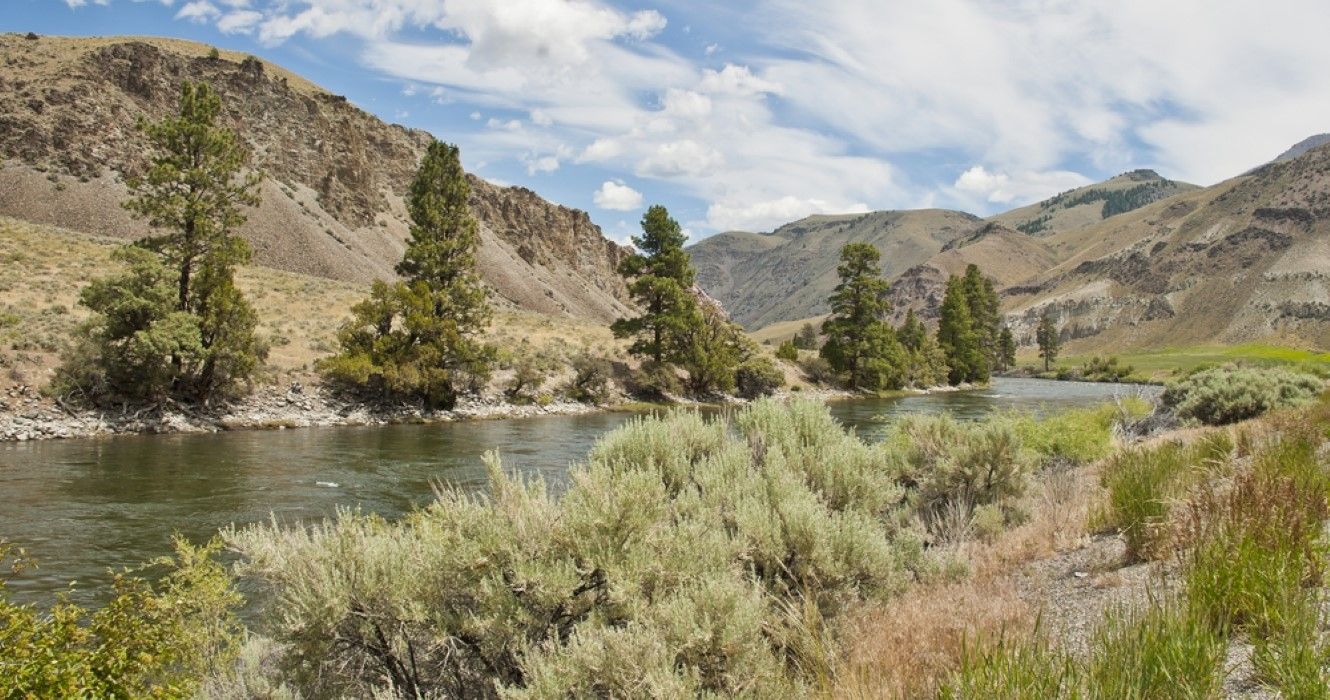Quick Links
Idaho is rife with natural beauty. Hundreds of years ago, the forests and rivers were navigated by Europeans for the first time. They found the wilderness rather challenging to overcome. The Salmon River, which originates in the ominously named Sawtooth Mountain Range, is the longest U.S. river that runs entirely within one state. It is geographically important for a number of reasons, most significantly as a natural time zone boundary separating Pacific and Mountain time.
- River: Salmon River
- State: Idaho
- Length: 425 miles (684km)
- Origin: Norton Peak of The Smoky Mountains, part of the Sawtooth Mountain Range
- River Mouth: Snake River
- First Mapped: 1805
The History Of The River Of No Return
In 1805, explorers Lewis and Clark set about on an expedition to navigate and map out Salmon River. They found the waters to be saturated with freshwater fish such as salmon and rainbow trout. The river was subsequently named after its primary wildlife resident, the salmon. In fact, Salmon River is home to up to 70% of all Chinook Salmon in the Columbia River Basin. Many of the species of salmon that are abundant in this River are listed as federally endangered species.
Lewis and Clark sailed downstream and discovered that the drops and rapids were so steep that, in addition to the fast current of the water, the river was nearly impossible to boat. They were forced to abandon the journey out of fear their boat might capsize. There was also the fear that one of the waterfalls might bring about their demise as the water rushed too quickly to row against.
They followed the river on foot instead, finding the surrounding land to be exorbitantly endowed and fertile. For decades, maps showing the Salmon River referred to it as Lewis River. It wasn't until the 1950s or so that the River was properly explored by Frank Lance, Hank the Hermit, and Buckskin Bill.
Buckskin Bill was the name given to Sylvan Ambrose Hart, who was an early American explorer. He famously lived on the banks of the Salmon River and provided much of the finer information and cartography related to the land. The river and its deposits are rich in minerals and sediments that are perfect for a thriving ecosystem. Buckskin Bill made the most of this natural richness and lived almost entirely off the land on the banks of the Salmon River. It is said that he spent less than $50 a year on his living essentials.
Why Is It Called The "River Of No Return"?
The 'River of no Return' is a dire label. It implies tragedy and supreme danger at the mercy of mother nature. The origin of the label, however, is not quite so dramatic.
The name came about after the river became a quasi-trading route. While sailors found it challenging to sail downstream, they found it completely impossible to sail upstream. Therefore, when sailors went down the Salmon River, it was with the foreknowledge that they would not come back the same way. Thus, it was aptly called the 'river of no return'.
It wasn't until the invention of the high-powered motorboat that the Salmon River was reverse navigated, but it is extremely challenging and dangerous nonetheless due to the depth of the gorges, waterfalls, and rapids.
Where Is The River Of No Return?
The Salmon River is located in Idaho. Some adventurous outdoors types partake in an 80-mile, six-day whitewater rafting trip down the Salmon River that begins in Corn Creek, Idaho, which is about 47 miles west of the town of North Fork. This would be a good place to start for visitors who are interested in boating the length of the river. The multi-day trip ends about 45 miles east of the town of Riggins, Idaho.
For casual visitors, the river can be accessed throughout the Sawtooth National Recreational Area, which is part of the Sawtooth National Forest. The park is free to enter, and the nearest town is Sun Valley, Idaho.
When To Visit The River Of No Return?
The worst time to visit Salmon River is between December and February. The temperatures are well below freezing. The water temperatures are also fatally cold without freezing over due to the motion of the water. Therefore, partaking in any water sports at this time is risky and can lead to hypothermia. It might indeed be the 'river of no return' during peak winter months.
The best time to visit is between April and October. This period spans spring, summer, and fall. In spring, the weather is still chilly, but the snow has thawed, and the flowers are blooming. The summer does not get too hot, and there's a cool, pleasant wind in the evening -- perfect for spending entire days out on the water. The fall is gorgeous, albeit a little windy. The foliage is a canvas of diverse, calming colors.

